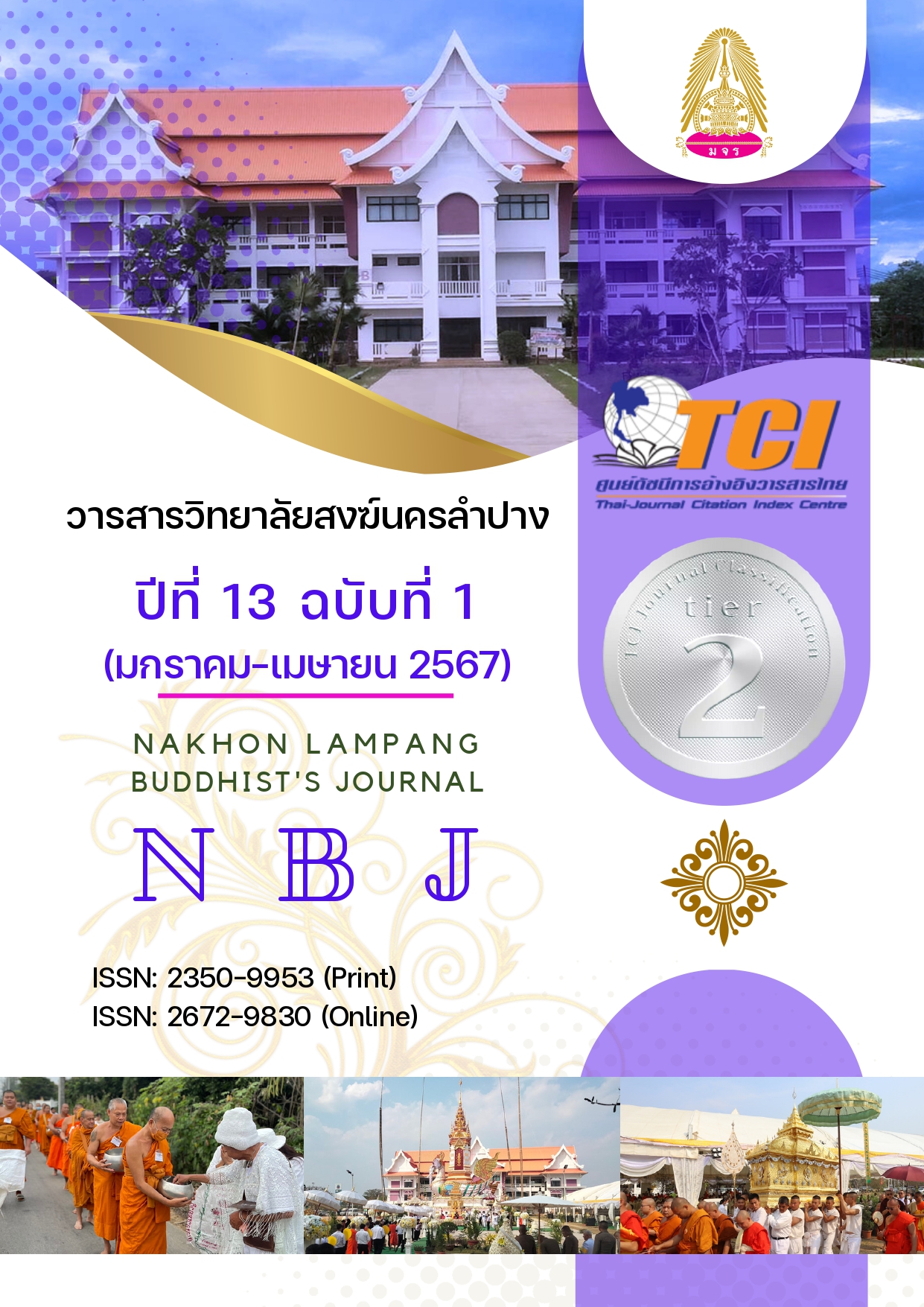ปัจจัยที่ส่งผลต่อการพูดภาษาอังกฤษของนักศึกษาระดับปริญญาตรี คณะศึกษาศาสตร์ มหาวิทยาลัยนอร์ทกรุงเทพ
Main Article Content
บทคัดย่อ
งานวิจัยนี้มีวัตถุประสงค์เพื่อ 1) ศึกษาระดับของปัจจัยที่ส่งผลต่อการพูดภาษาอังกฤษของนักศึกษา คณะศึกษาศาสตร์ มหาวิทยาลัยนอร์ทกรุงเทพ 2) ศึกษาปัจจัยที่ส่งผลต่อการพูดภาษาอังกฤษของนักศึกษา คณะศึกษาศาสตร์ มหาวิทยาลัยนอร์ทกรุงเทพ กลุ่มตัวอย่างคือ นักศึกษาปริญญาตรี คณะศึกษาศาสตร์ มหาวิทยาลัยนอร์ทกรุงเทพ จำนวน 179 คน โดยการสุ่มอย่างง่าย ใช้แบบสอบถามเป็นเครื่องมือในการเก็บรวมรวมข้อมูล วิเคราะห์ข้อมูลโดยใช้ค่าความถี่ ค่าร้อยละ ค่าเฉลี่ย ค่าเบี่ยงเบนมาตรฐาน และวิเคราะห์การถดถอยพหุคูณ ด้วยวิธี Stepwise
ผลการวิจัยพบว่า 1) ปัจจัยที่ส่งผลต่อการพูดภาษาอังกฤษของนักศึกษาระดับปริญญาตรี คณะศึกษาศาสตร์ มหาวิทยาลัยนอร์ทกรุงเทพ โดยภาพรวม อยู่ในระดับปานกลาง 2) ผลการทดสอบสมมติฐานพบว่าปัจจัยส่งผลต่อการพูดภาษาอังกฤษของนักศึกษาระดับปริญญาตรี คณะศึกษาศาสตร์ มหาวิทยาลัยนอร์ทกรุงเทพ ได้แก่ ด้านทัศนคติในการเรียน (x6) ด้านพื้นฐานความรู้เดิม (x3) ด้านครอบครัว (x7) โดยสามารถร่วมกันพยากรณ์ความสามารถในการพูดภาษาอังกฤษได้อย่างมีนัยสำคัญทางสถิติที่ระดับ 0.05 และสามารถอธิบาย ความสามารถในการพูดได้ร้อยละ 58.11 และสามารถเขียนเป็นสมการได้ดังนี้
สมการคะแนนดิบ
= 4.342 + 2.174X6 + 1.600X3 + 0.819X7
สมการคะแนนมาตรฐาน
= 0.394X6 + 0.318X3 + 0.167X7
Article Details

อนุญาตภายใต้เงื่อนไข Creative Commons Attribution-NonCommercial-NoDerivatives 4.0 International License.
เอกสารอ้างอิง
Brown, H. D. (2007). Principles of language learning and teaching. New York: Pearson Education.
Budianto, L. (2010). Students’ Psychological Factors in SLA: A Dillema for Teachers of English. Journal of Lingua, 5(1). 62-67.
Burns, A., & Joyce, H. (1997). Focus on Speaking. Sydney: National Centre for English Language Teaching and Research.
Bhattacharya, S. (2017). A study on the factors affecting ESL learners’ English-speaking skills. International Journal of English Researc, 3(4), 31-37.
Craft, A. (2005). Creativity in Schools: Tensions and Dilemmas. London: Routledge.
Cummins, J. (1981). The role of primary language development in promoting educational success for language minority students. In Schooling and language minority students: A theoretical framework (pp. 3-49). Los Angeles: California State University.
Crystal, D. (2003). English as a Global Language. Cambridge, UK: Cambridge University Press.
Duff, P. (2007). Second Language Socialization as Sociocultural Theory: Insights and Issues. Language Teaching, 40(4), 309-319.
Ellis, R. (2003). Task-Based Language Learning and Teaching. Oxford, UK: Oxford University Press.
Ellis, R. (2008). The Study of Second Language Acquisition. London: Oxford University Press,
Freeman, D. (1998). Doing teacher research: From inquiry to understanding. Boston: Heinle and Heinle.
Falmer. Coleman, J. A. (1996). Studying Abroad: The Experience of American Undergraduates. Connecticut: Greenwood Publishing Group.
Gardner, R. C. (1985). Social Psychology and Second Language Learning: The Role of Attitudes and Motivation. London: Edward Arnold.
Guffey, M., Loewry, D., & Griffin, E. (2019). Business communication: Process and product. Toronto. ON: Nelson Education.
Harmer, J. (2007). The Practiceof English Language Teaching. (4th ed.). London : Pearson Longman.
Hettiarachchi, G. S., & Jayasinghe, R. M. (2018). Simulation in Language Teaching and Learning: An Overview. International Journal of Scientific and Research Publications, 8(11), 386-389.
Hoff, E. (2013). Interpreting the Early Language Trajectories of Children from Low-SES and Language Minority Homes: Implications for Closing Achievement Gaps. Developmental Psychology, 49(1), 4–14. doi:10.1037/a0027238.
Johnson, D. W., & Johnson, R. T. (1999). Learning Together and Alone: Cooperative, Competitive, and Individualistic Learning. (5th ed.). Boston, MA: Allyn and Bacon.
Kolb, D. A. (1984). Experiential Learning: Experience as the Source of Learning and Development. Englewood Cliffs, NJ: Prentice Hall.
Kramsch, C. (2009). The Multilingual Subject. Oxford: Oxford University Press.
Krashen, S. D. (1982). Principles and Practice in Second Language Acquisition. New York, NY: Pergamon Press.
Krashen, S. (1988). The Natural Approach: Language Acquisition in the Classroom. New Jersey: Prentice Hall Europe.
MacIntyre, P. D., & Gardner, R. C. (1991). Language Anxiety: Its Relationship to Other Anxieties and to Processing in Native and Second Languages. Language Learning, 41(4), 513-534.
Mckay, S. L. (2002). Teaching English as an International Language: Rethinking Goals and Approaches. Oxford, UK: Oxford University Press.
Nation, P. (2001). Learning Vocabulary in Another Language. Cambridge, UK: Cambridge University Press.
Nunan, D. (2003). Nine Steps to Leaner Autonomy. In Nunan, D. [Ed.]. Practical English Language. Teaching. New York: McGraw Hill.
Phithakphongphan, T. (2021). Internal Factors Obstructing Thai Students’ English Speaking Skill: The Influence of Thai Cultural Concepts. Inthaninthasin Journal, 16(2), 53-69.
Ritthirat, N. (2014). Thai University Students' English Oral Proficiency and Problems to Developing English Speaking Skill. (Master’s Thesis). Prince of Songkhla University. Songkhla.
Richard, J. C. & Renanday, W. A. (2002). Methodology in Language Teaching: An Anthropology of Current Practice. Cambridge: Cambridge University Press.
Richards, J.C. & Lockhart, C. (1994). Reflective Teaching in Second Language Classrooms. Cambridge: Cambridge University Press.
Skehan, P. (1998). A cognitive approach to language learning. Oxford: Oxford University Press.
Thitisupakul, P. et al. (2016). A study of factors affecting the results of teaching and learning. English language of schools under Bangkok. Peace Studies Review Journal, 4(2). 245-259.
Tabors, P. O. (2008). One Child, Two Languages: A Guide for Early Childhood Educators of Children Learning English as a Second Language. Baltimore, MD: Paul H Brookes Publishing.
Warschauer, M., & Healey, D. (1998). Computers and Language Learning: An Overview. Language Teaching, 31(2), 57-71.
Warschauer, M., & Grimes, D. (2007). Audience, Authorship, and Artifact: The Emergent Semiotics of Web 2.0. Annual Review of Applied Linguistics, 27, 1-23.
Yamane, T. (1973). Statistics: an introductory analysis. New York: Harper & Row.

